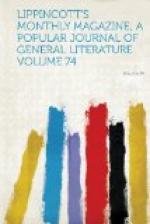The sciences, like the nations and like bees, as they grow too large for their hive are perpetually swarming and colonizing. Not that colonization is followed, as in the case of the similitude, by independence. Their mutual bonds become closer and closer. But convenience and (so to speak) comfort require the nominal separation. So electricity sets up for itself; and chemistry, the metropolis, swells into other offshoots. So numerous and so great are these that the old alchemists, unlimited range through the material, immaterial and supernatural as they claimed for their art, would rub their eyes, bleared over blowpipe and alembic, at sight of its present riches. The half-hewn block handed down by these worthies—not by any means
Like that great Dawn which baffled Angelo
Left shapeless, grander for its mystery,
but blurred and scratched all over with childish and unmeaning scrawls—has been wholly transformed. Chemistry no longer assumes to read our future, but it does a great deal to brighten our present. Laboring to supply the wants and enhance the pleasures and security of daily life, it makes excursions with a sure foot in the opposite direction of abstruse problems in natural philosophy. It analyzes all substances, determines their relations, and tries to guide the artisan in utilizing its acquisitions for the general good. To enumerate these, or to give the merest sketch of chemical progress within the century, would fill many pages. It has enriched and invigorated all the arts by supplying new material and new processes. Illuminating gas, photography, the anaesthetics, the artificial fertilizers, quinine, etc. are a few of its more familiarly known contributions. It has aided medical jurisprudence, and so far checked crime. Besides enlarging the pharmacopoeia, it has promoted sanitary reform in many ways, notably by ascertaining the media of contagion in disease and providing for their detection and removal. Its triumphs are so closely interwoven with the appliances of common life that we are prone to lose sight of them. From the aniline dye that beautifies a picture or a dress, to the explosive that lifts a reef or mines the Alps for a highway, the gradations are infinite and multiform.




